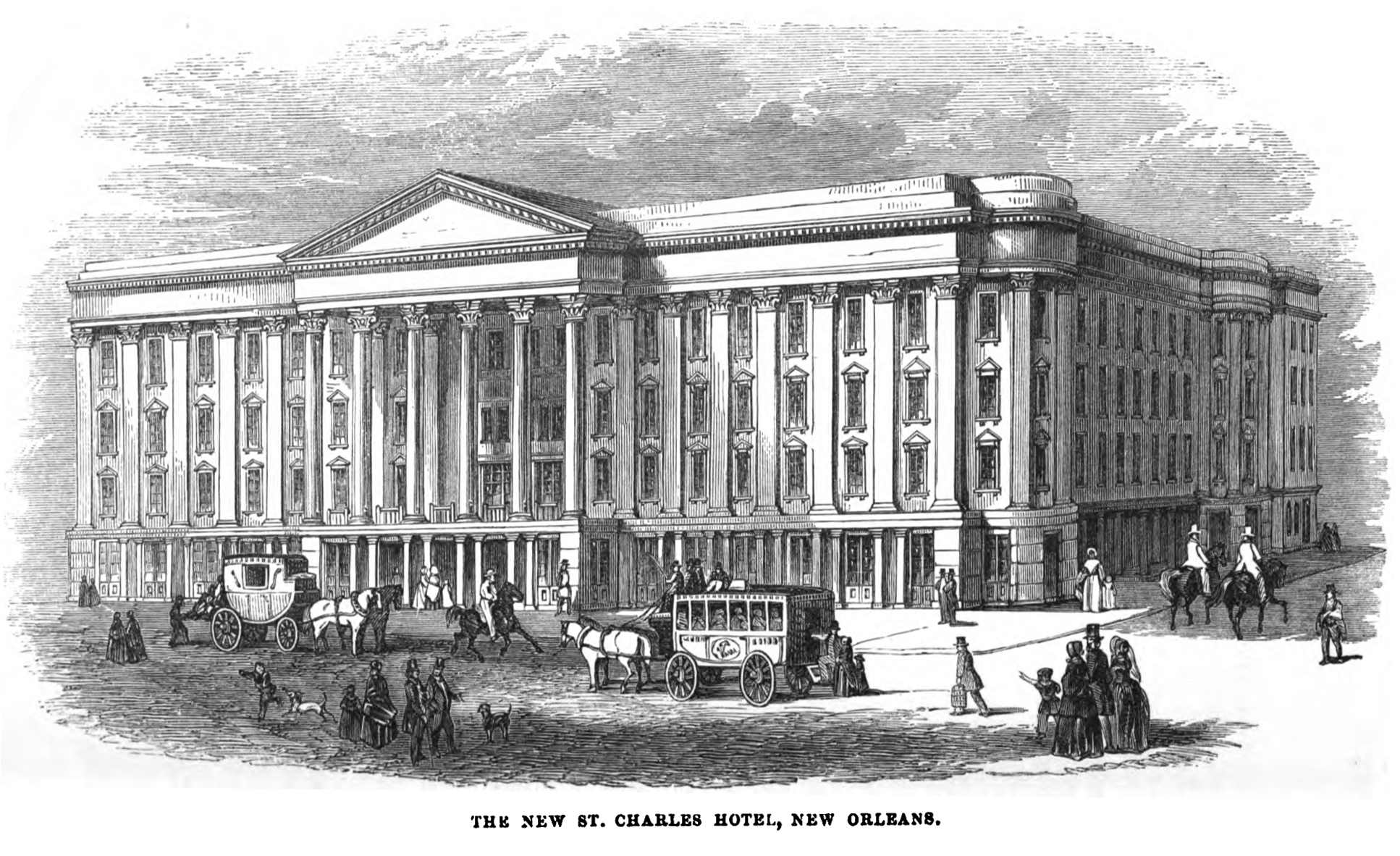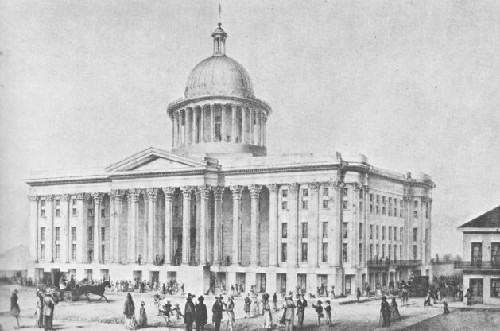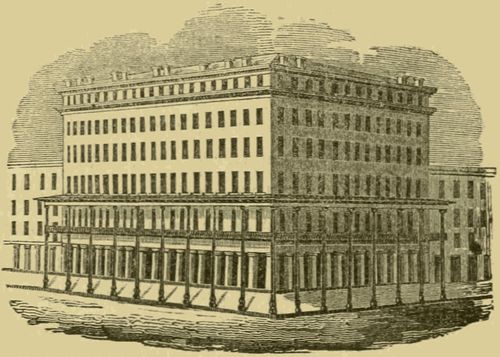
The St. Charles Hotel In New Orleans
One of the significant locations in my novel, Painter of Dreams, is the St. Charles Hotel in New Orleans, which is where Brandon and Captain Henderson stayed. The hotel figures into my fourth novel as well.
In 1851, a fire destroyed the original hotel. It was rebuilt in 1852. The large illustration above is of the second hotel .The hotel was in business until 1973.
This is what the original hotel looked like. The second, as you can see, was similar, but much plainer. It didn’t have the fancy cupola.

Here’s a description of the hotel from Benjamin Moore Norman’s, Norman’s New Orleans and Environs, published in 1845.
“This magnificent establishment, which, for size and architectural beauty, stands unrivaled, was commenced in the summer of 1835, and finished in the May of 1838, by an incorporated company. The building was designed by, and erected under the superintendence of J. Gallier, architect, at an expense of $600,000, including the ground it stands on, which cost $100,000. It presents fronts on three streets. The principal one on St. Charles street, consists of a projecting portico of six Corinthian columns, which stand upon a granite basement fourteen feet high, with a pediment on the top, and four similar columns on each side of the portico, placed in a range with the front wall; behind which is formed a recess fifteen feet wide and one hundred and thirty-nine long, and floored over with large granite slabs, which, supported on iron beams, serve as a ceiling to that portion of the basement story standing under the portico; and on top affords a delightful promenade under the shade of the portico and side columns. The entrance to the bar room is under this; and the outside steps, leading from the street to the portico, are placed on each side thereof, between it and the front range of the building. In one of the rear angles of the basement is a bathing establishment, consisting of fourteen rooms, elegantly fitted up, with every convenience for hot or cold bathing. On the opposite angle are placed the wine cellars, store-house, and other domestic apartments. All the remaining parts of the basement are divided into stores, which are rented out to various trades-people. The bar room is in the basement, near the centre of the edifice; and is octangular in the plan, seventy feet in diameter, and twenty high; having an interior circular range of Ionic columns, distributed so as to support the weight of the floors and partitions of the upper stories. The architecture of this room is Ionic. That of the saloon, which is immediately over the bar room, is of the Corinthian order, and eighteen feet ceiling. A grand spiral stair-case commences upon the centre of the saloon floor, and is continued up to the dome. Around this stair-case, on each side of the upper stories, a gallery is formed, which gives access to six bedrooms within the octagon, on each of the six upper stories. As the bar room is six feet higher than the other parts of the basement, the entrance to the saloon from the portico is by a flight of marble steps, twelve in number, and thirty-five feet long. On the top of these steps is placed a beautiful marble statue of Washington, presented to the company by John Hagan, Esq.
The gentlemen’s dining and sitting rooms occupy the whole side of the building on Gravier street. The dining room, with a pantry at the end, is one hundred and twenty-nine feet long by fifty wide, and twenty-two feet high, tastefully finished in the Corinthian order, with two inside ranges of columns, so placed that there is abundant space for four ranges of dining tables, sufficient to accommodate five hundred persons. The ladies’ dining room is placed over the bathing apartments, and is fifty-two by thirty-six feet. The kitchen, fifty-eight by twenty-nine feet, is placed in the rear wing of the building, on the same story with, and in the centre between the two dining rooms. The two angles of the principal front contain the ladies’ drawing room, and the gentlemen’s sitting room, the former forty by thirty-two feet, the latter thirty-eight feet square. There are nine private parlors on the second story, to some of which are attached adjoining bedrooms; and the same number on the upper stories. There are four stories of elegantly furnished and well lighted bedrooms, all around the four sides of the building, with central passages, or corridors, which communicate with the centre and with each other, having three stair-cases opening to the corridors, besides the grand stair-case in the octagon. There are, in the edifice, three hundred and fifty rooms.
A dome, of beautiful proportions, after a plan of Dakin, forty-six feet in diameter, surmounts the octagon building, elevated upon an order of fluted columns, which stand eleven feet from the dome, around the outside, and on the dome is elevated an elegant little Corinthian turret. There is a large circular room under the dome, on the floor of which the spiral stair-case terminates, and around the outside of which the circular colonade forms a beautiful gallery eleven feet wide, from whence can be seen the whole city, and all the windings of the river for several miles in each direction. The effect of the dome upon the sight of the visitor, as he approaches the city, is similar to that of St. Paul’s, London.
No better evidence can be adduced — nor more flattering encomiums presented to the architects, than the fact of the indescribable effect of the sublime and matchless proportions of this building upon all spectators — even the stoical Indian and the cold and strange backwoodsman, when they first view it, are struck with wonder and delight. The view of this structure by moonlight is a sight not easily described. The furnishing of this establishment cost $150,000.”
